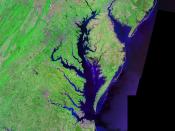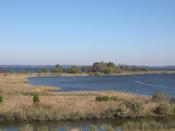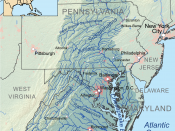Chesapeake Bay Report Ellen Denker The Chesapeake Bay Ecosystem The Chesapeake Bay ecosystem is a great resource. It houses many types of animals, plants and marine life. People eat from it and play in it. The Chesapeake Bay receives about half its water volume from the Atlantic Ocean and the rest drains into the Bay from parts of New York, Pennsylvania, West Virginia, Delaware, Maryland and Virginia and the entire District of Columbia. It is a threatened resource. Loss of habitat, overharvesting, pollutions and disease are some of the reasons it needs to be protected.
Geology of the Chesapeake Geologic History of the Bay can be summarized by saying it originally came from glacier activity long ago. About 10,000 years ago it began forming as it is now when they started to melt and since about 3000 years ago it was like it is today. The Chesapeake Bay is approximately 200 miles long but contains more than 4,400 miles of shoreline.
The average depth is only 27 feet. The Bay lies totally within the Atlantic Coastal Plain which is a flat, low land area with a maximum elevation of about 300 feet above sea level. Because of the different types of terrain water flows from into the bay it has a lot of different types of chemicals in it. Some of those include dense crystalline rock like slates, marble and granite, plus sandstone, siltstone, shale and limestone.
Water and Sediments "Estuarine systems offer the greatest physical variability in water composition. An estuary, according to oceanographer Donald W. Pritchard, is a "... semi-enclosed body of water which has free connection with the open sea and within which sea water is measurably diluted by freshwater from land drainage."� Within an estuary, freshwater mixes with salt water, with each contributing its own chemical...


